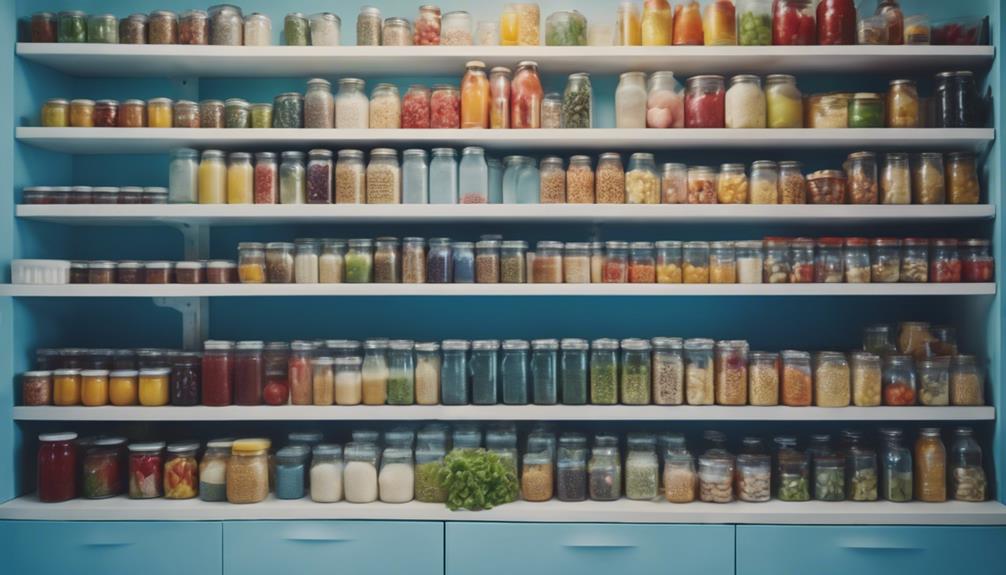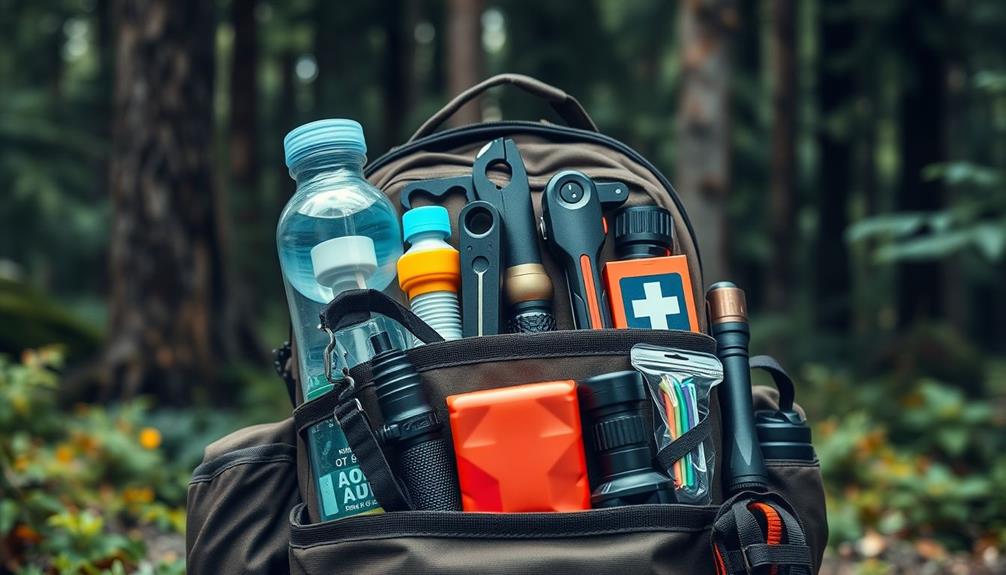When it comes to prepping, having a well-stocked food supply is essential. Focus on non-perishable items with a minimum one-year shelf life, like grains, beans, and canned goods. Don't forget essentials like baking supplies, spices, and oils for flavor and nutrition. Prioritize protein sources like canned meats, beans, and nuts, and include a variety of fruits and veggies for balanced nutrition. Store your supplies in airtight containers in a cool, dark place, and rotate items regularly to guarantee freshness. By stockpiling the right foods, you'll be prepared for emergencies and have peace of mind knowing you're ready for whatever comes next.
Key Takeaways
- Stockpile non-perishable foods with a minimum one-year shelf life, focusing on grains, beans, and canned goods for a well-rounded supply.
- Use mylar bags and oxygen absorbers to preserve food, and invest in proper storage methods like airtight containers to maintain freshness.
- Prioritize essential food categories, including grains, beans, canned goods, fats, and spices, to ensure a versatile and nutritious food supply.
- Rotate food supplies regularly, checking expiration dates and replacing expired items to maintain a fresh and usable stockpile.
- Consider dietary restrictions and preferences when stocking up, and store food in a cool, dark place to extend shelf life and preserve nutrients.
Building a Survival Pantry
When building a survival pantry, it's important to focus on stockpiling non-perishable foods with a minimum one-year shelf life to guarantee you have a reliable source of sustenance during extended emergencies. Concentrate on shelf-stable items like grains, beans, and canned goods, which are essential for a well-rounded survival pantry.
Proper food preservation techniques, such as using mylar bags and oxygen absorbers, can extend the shelf life of these items. Investing in proper storage methods, like airtight containers, will also help maintain the quality of your supplies.
Don't forget to stock up on baking supplies and other essential items to ensure you have a versatile and nutritious food supply. By doing so, you'll be ready for emergency situations and can rest assured that you have a reliable source of sustenance.
Essential Food Categories

What essential food categories should you prioritize to guarantee a well-rounded diet in your prepper pantry?
When stockpiling food for emergencies, it's important to focus on categories that provide a balanced mix of carbohydrates, proteins, fats, and essential nutrients.
Here are the top five essential food categories to include in your prepper pantry:
- Grains: Rice, pasta, and other grains offer energy and sustained carbohydrates.
- Beans: Rich in protein and fiber, beans are an excellent source of plant-based nutrition.
- Canned Goods: Canned meats, vegetables, and fruits ensure a long shelf life and variety in your pantry.
- Fats: Canned meats, oils, and other fatty foods add flavor and nutritional value to your meals.
- Spices: Don't forget to stock up on herbs and spices to add flavor and depth to your survival meals.
Stocking Up on Grains

You're likely already familiar with the importance of grains in your prepper pantry, so let's explore the best ways to stock up on these energy-boosting staples. Grains like rice, pasta, and flour are must-haves due to their long shelf life and versatility in meals.
Whole grains provide carbohydrates for energy, making them ideal for emergency situations where energy is vital. Stocking up on a variety of grains guarantees a well-rounded diet and meal options during extended periods of survival.
To maintain freshness and prevent spoilage, store grains in airtight containers in a cool, dark place. Consider grinding grains before use for maximum freshness and nutrient retention in your prepper pantry. This simple step can make a big difference in the quality of your stored grains.
Protein Sources for Emergencies

When it comes to protein sources for emergencies, you'll want to contemplate meat options that matter.
Canned fish, in particular, offers a variety of benefits, including a long shelf life and rich nutritional value.
Meat Options Matter
Stocking a prepper's pantry with a variety of meat options provides a vital source of protein during emergencies. It's important to take into account the convenience, shelf life, and nutritional value of each option.
When building your emergency food supply, consider the following meat options:
- Canned meats: Tuna, chicken, and beef jerky are convenient protein sources with long shelf lives.
- Freeze-dried meats: These provide high-quality protein and can last for years in proper storage conditions.
- Plant-based proteins: Beans, lentils, and nuts are nutritious alternatives to meat in a prepper's food supply.
- Canned beans: Versatile protein sources that require minimal preparation during emergencies.
- Dried beans: A nutritious and shelf-stable option that can be used in a variety of dishes.
Incorporating these protein-rich options into your meat supply ensures a well-rounded and dependable source of nutrition during emergencies. By considering the unique benefits of each option, you can create a thorough emergency food supply that meets your protein needs.
Canned Fish Variety
Incorporating a variety of canned fish into your emergency food supply provides a convenient and nutrient-dense source of protein that's ready to fuel your body in times of crisis. As a prepper, you want to guarantee you have a reliable source of protein to sustain you through survival situations.
Canned fish like tuna, salmon, and sardines are excellent options that fit the bill. These shelf-stable foods are packed with essential nutrients like omega-3 fatty acids, making them a great addition to your prepper pantry.
Canned fish are also incredibly versatile, allowing you to incorporate them into various recipes or consume them straight from the can. With a long shelf life, you can stock up on these essentials without worrying about them going bad.
Having a variety of canned fish in your emergency food supply ensures you'll have a diverse range of protein sources to keep you going. So, don't overlook the importance of canned fish in your emergency food planning – they're a convenient, nutritious, and reliable choice for any prepper.
Maximizing Nutritional Value

To guarantee your preppers food supply provides the energy and sustenance you need to survive, focus on selecting foods that pack a nutritional punch. When stocking up, prioritize nutrient-dense foods like beans, nuts, and seeds, which offer a rich source of essential vitamins, minerals, and fiber.
Incorporate a variety of fruits and vegetables in your pantry to make sure you're getting a broad range of nutrients.
Consider adding vitamin packs to your supply to supplement your diet and fill any nutritional gaps.
Healthy fats and natural sweeteners like nut butters, oils, honey, and maple syrup add flavor and nutrients to your survival meals.
Opt for whole grains and protein sources like peanut butter and jerky to maintain a balanced diet.
Don't forget to include a mix of canned goods to round out your supply.
Beverage and Hydration Options

You'll want to prioritize beverage and hydration options in your preppers food supply, as access to clean drinking water and comforting drinks can be a lifesaver in emergency situations. Important hydration is vital for overall health and survival during crises, so it's critical to include hydration essentials in your prepper food supply.
A well-stocked pantry should have a variety of beverages, such as coffee and tea, which can provide comfort and a morale boost. Rotating stored water is also vital to guarantee freshness and availability when you need it most.
When it comes to emergency preparedness, staying hydrated is key. Include hydration options in your prepper food supply to stay prepared for unforeseen circumstances. Having a range of beverage options can help maintain morale and well-being during difficult times.
Don't forget to store water purification tablets or filters to make sure access to clean drinking water. By prioritizing hydration options in your prepper food supply, you'll be better equipped to handle emergency situations and stay prepared for whatever comes your way.
Organizing Your Food Supply

Six essential steps can turn your prepper food supply into a well-oiled machine:
- Categorize items by type
- Use clear containers or labels
- Rotate food regularly
- Create a pantry inventory list
- Utilize storage racks
- Maximize space.
By following these steps, you'll be able to efficiently store and manage your foods, guaranteeing you're always prepared for any situation.
Here are some key tips to keep in mind when organizing your food supply:
- Categorize foods into sections like grains, proteins, and canned goods to make them easy to find
- Use clear containers or labels to identify contents at a glance
- Rotate foods regularly to ensure older items are used before they expire
- Create a pantry inventory list to track what you have and what you need to restock
- Utilize storage racks and shelves to maximize space and keep items off the floor.
Frequently Asked Questions
What Is the Best Survival Food to Stock up On?
When considering the best survival food to stock up on, you should prioritize calorie-dense, nutrient-rich options like nuts, seeds, and dried fruits that are shelf-stable, versatile, and require minimal preparation.
What Foods to Stock up on for Long Term Storage?
When stockpiling for long-term storage, focus on shelf-stable staples like rice, pasta, and canned goods with a minimum one-year shelf life, plus protein-rich dried beans, nuts, and seeds for sustained nutrition.
What Do Preppers Stock up On?
You stock up on long shelf-life foods like grains, beans, and canned goods, as well as non-perishable proteins, fruits, and veggies, plus spices, sweeteners, and vitamin packs for a well-rounded diet.
What to Stockpile for an Emergency?
When stockpiling for an emergency, prioritize shelf-stable foods with a one-year shelf life, including grains, beans, canned goods, and dried fruits, to guarantee a well-rounded and nutritious supply that meets your needs.
What Types of Food Should I Include in My Preppers Food Supply?
When stocking your essential preppers gear pack, make sure to include non-perishable items like canned goods, dried fruits, and nuts. Also, consider long-lasting staples such as rice, pasta, and beans. Don’t forget about essential items like salt, sugar, and cooking oil to complete your preppers food supply.
Conclusion
You've stocked your pantry, and now you're ready to face the unknown. Like an ant preparing for winter, you've gathered the essentials to weather any storm.
Remember, a well-stocked pantry is like having a safety net – it's a reassuring feeling to know you're prepared for anything life throws your way.
So, take a deep breath, and rest easy knowing you've got this. You're ready to ride out the storm, and emerge stronger on the other side.










